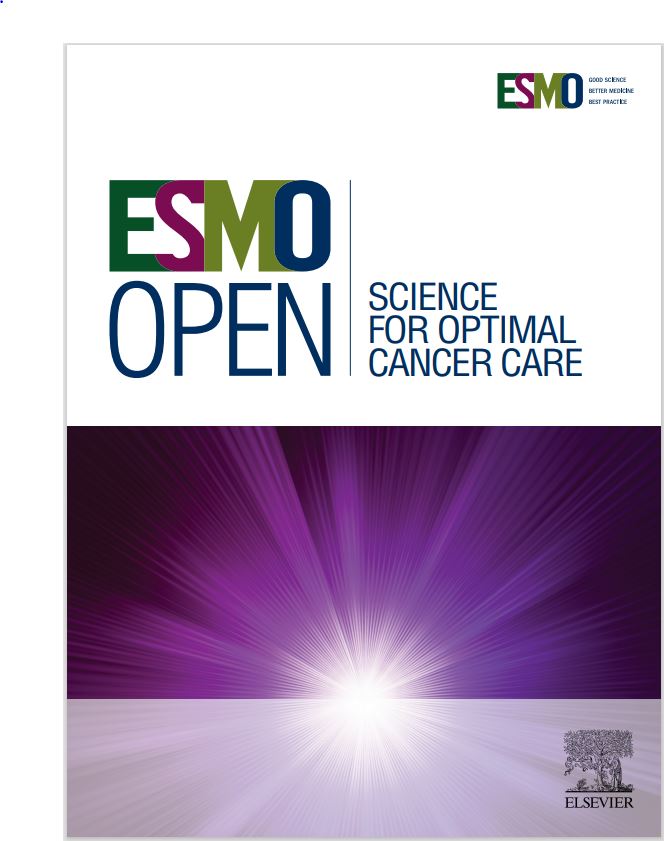Conditional progression-free survival in patients with metastatic hormone receptor-positive, human epidermal growth factor receptor 2-negative breast cancer treated with first-line ribociclib and endocrine therapy: real-world data from the RIBANNA study
IF 7.1
2区 医学
Q1 ONCOLOGY
引用次数: 0
Abstract
Background
Progression-free survival (PFS) for patients with metastatic hormone receptor-positive (HR+), human epidermal growth factor receptor 2-negative (HER2−) breast cancer significantly improved with cyclin-dependent kinase 4/6 inhibitors as part of first-line treatment. No data is available for these patients on how the risk of progression evolves. Therefore, we analyzed conditional PFS (cPFS), which reflects patient prognosis after initial management, that is, the probability of remaining free from progression in those who have already survived without progression for a given period.
Patients and methods
We analyzed PFS and cPFS for patients free from progression after 12, 24, and 36 months (reference time points) treated with ribociclib and endocrine therapy (ET) as first-line treatment for advanced HR+, HER2− breast cancer (aBC) within the RIBANNA noninterventional study (NCT06311383). Relevant subgroups with established prognostic factors were additionally examined.
Results
Compared with the median PFS of 35 months (95% confidence interval 32.3-38.4 months) in the overall population, the median cPFS was higher for all reference points: cPFS of 40.5 months (95% confidence interval 35.0-45.5 months) for patients who were progression-free 12 months, cPFS of 53.6 months (95% confidence interval 42.7-not reached months) for 24 months reference point, whereas for the 36 months reference point, the median cPFS was not reached. After patients had reached 2-year disease control, the initial presence of liver metastases or grade 3 disease no longer qualified as poor prognostic factors; internal organ metastases (central nervous system, liver, and lungs) showed a diminishing prognostic impact over time. A short treatment-free interval remained a relevant prognostic factor.
Conclusion
For the first time, increasing cPFS was demonstrated in patients treated with ribociclib and ET. Such information is highly relevant and reassuring for patients with HR+, HER2− aBC, and could be used to aid patient counseling and treatment decision-making, including possible de-escalation strategies. It is also a starting point for identifying dynamic prognostic factors related to long-term survival.
转移激素受体阳性、人表皮生长因子受体2阴性乳腺癌患者接受一线核糖环尼和内分泌治疗的条件无进展生存期:来自RIBANNA研究的真实数据
细胞周期蛋白依赖性激酶4/6抑制剂作为一线治疗的一部分,转移激素受体阳性(HR+)、人表皮生长因子受体2阴性(HER2−)乳腺癌患者的无进展生存期(PFS)显著改善。没有关于这些患者进展风险如何演变的数据。因此,我们分析了条件PFS (cPFS),它反映了患者在初始治疗后的预后,即在给定时间内存活而无进展的患者保持无进展的概率。患者和方法在RIBANNA非介入研究(NCT06311383)中,我们分析了接受核糖环尼和内分泌治疗(ET)作为一线治疗的晚期HR+, HER2−乳腺癌(aBC)患者在12、24和36个月(参考时间点)后无进展的PFS和cPFS。另外检查具有确定预后因素的相关亚组。结果与总体人群中35个月的中位PFS(95%置信区间32.3-38.4个月)相比,所有参考点的中位cPFS都更高:无进展12个月的患者cPFS为40.5个月(95%置信区间35.0-45.5个月),24个月参考点的cPFS为53.6个月(95%置信区间42.7-未达到月),而36个月参考点的中位cPFS未达到。在患者达到2年疾病控制后,最初存在肝转移或3级疾病不再符合不良预后因素;随着时间的推移,内部器官转移(中枢神经系统、肝脏和肺部)对预后的影响逐渐减弱。短的无治疗间隔仍然是一个相关的预后因素。结论首次证实,接受核糖环尼和ET治疗的患者的cPFS增加。这一信息对HR+、HER2−aBC患者具有高度相关性和令人放心的意义,可用于帮助患者咨询和治疗决策,包括可能的降级策略。它也是确定与长期生存相关的动态预后因素的起点。
本文章由计算机程序翻译,如有差异,请以英文原文为准。
求助全文
约1分钟内获得全文
求助全文
来源期刊

ESMO Open
Medicine-Oncology
CiteScore
11.70
自引率
2.70%
发文量
255
审稿时长
10 weeks
期刊介绍:
ESMO Open is the online-only, open access journal of the European Society for Medical Oncology (ESMO). It is a peer-reviewed publication dedicated to sharing high-quality medical research and educational materials from various fields of oncology. The journal specifically focuses on showcasing innovative clinical and translational cancer research.
ESMO Open aims to publish a wide range of research articles covering all aspects of oncology, including experimental studies, translational research, diagnostic advancements, and therapeutic approaches. The content of the journal includes original research articles, insightful reviews, thought-provoking editorials, and correspondence. Moreover, the journal warmly welcomes the submission of phase I trials and meta-analyses. It also showcases reviews from significant ESMO conferences and meetings, as well as publishes important position statements on behalf of ESMO.
Overall, ESMO Open offers a platform for scientists, clinicians, and researchers in the field of oncology to share their valuable insights and contribute to advancing the understanding and treatment of cancer. The journal serves as a source of up-to-date information and fosters collaboration within the oncology community.
 求助内容:
求助内容: 应助结果提醒方式:
应助结果提醒方式:


